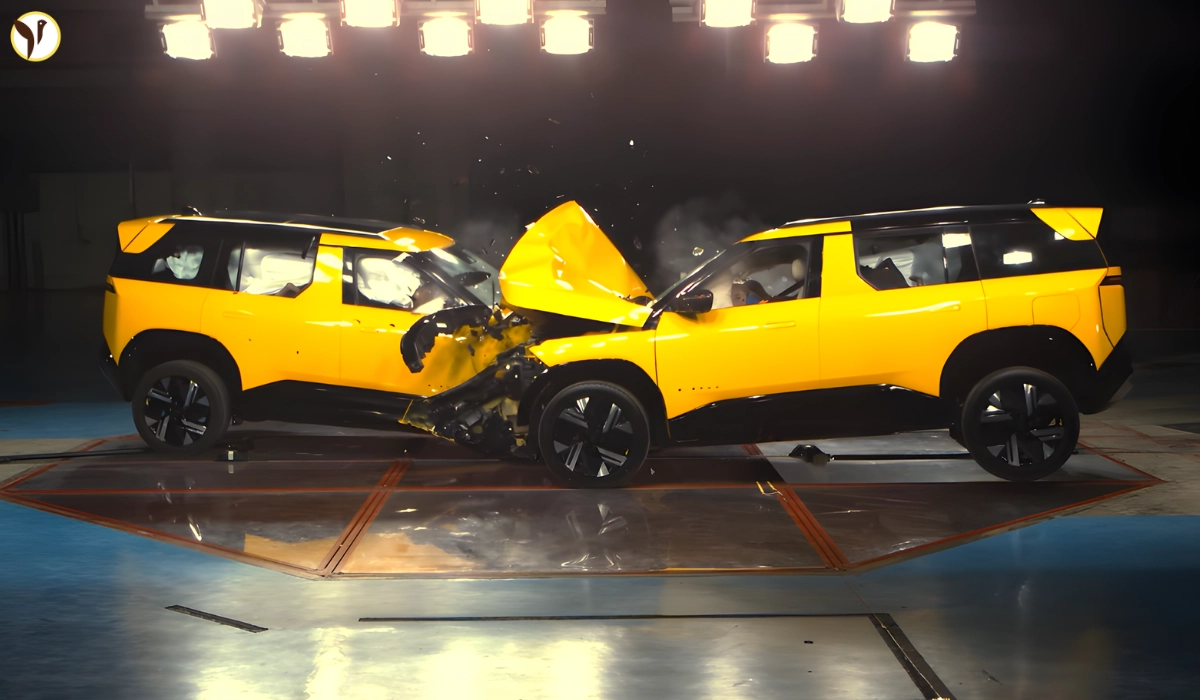Tata is making noise again—this time not for design, pricing, or features, but for safety. The latest Tata Sierra crash test shows a direct car-to-car collision, something rarely performed in crash assessments for SUVs in this segment. The Sierra isn’t even officially launched yet, but safety data is already becoming the center of discussion. With the global audience focusing more on real-world crash protection than just lab scores, the Sierra test results are grabbing attention faster than expected.
What Makes This Crash Test Different?
The standout thing about the Tata Sierra crash test is that it was conducted using a real car-to-car collision simulation instead of a traditional barrier crash. This gives a much clearer idea of how the Sierra would protect passengers in an actual highway accident scenario. The Sierra’s structure absorbed impact efficiently, reducing cabin deformation while ensuring head, chest and knee protection for both front passengers. Testing teams noted that the SUV’s body control and crumple zone performance were beyond standard benchmark levels for this category, indicating Tata’s increasing focus on global safety norms—not just Indian compliance.
How Safe Did Tata Sierra Really Perform?
From the data available so far, the Tata Sierra’s safety cell remained stable during the impact, which is a strong indication of good build strength. The side intrusion was minimal, and even the rear seat dummies recorded low injury probability, showing that the safety protection is not limited to only the front row. Airbag deployment timing and seatbelt load limiters worked exactly in sync, preventing whiplash and head collision. Safety experts believe the Sierra could comfortably score 5 stars for adult & child protection if this data mirrors official scoring when the model is finally tested under international protocols.
Specifications Seen in the Crash-Tested Tata Sierra
|
|
|
|
|
|
|
|
|
|
|
|
|
|
|
|
|
|
|
|
|
|
|
|
What This Means for the US & Global Market
The Tata Sierra may initially be planned for the Indian market, but the crash test signals Tata's serious ambition for global entry. US buyers have been increasingly vocal about affordability + safety + electric options, and the Sierra seems designed to tick all three boxes. The SUV’s robust crash behavior and rumored ADAS features make it a potential competitor to compact electric crossovers already sold in the States. With automakers shifting towards more realistic crash test environments, Sierra’s performance places Tata in a stronger position to challenge international players.
Tata went one step further with the crash testing of the new Sierra! #TataSierra pic.twitter.com/0GoJ5wMB05
— carandbike (@carandbike) November 25, 2025
Why the Tata Sierra Is Getting So Much Hype
People love SUVs that look cool but also protect families, and the Sierra appears to be hitting that sweet spot. Its blend of rugged design, modern tech, safety-first engineering, and EV-friendly platform is helping it trend even before its official release. Social media car communities are calling it the “comeback icon,” and if Tata follows through with a strong global pricing strategy, the Sierra might become their most talked-about international model yet.
Final Thought
The Tata Sierra crash test shows car-to-car collision performance that’s more than marketing hype — it’s a sign of a brand growing up globally. If Tata keeps pushing safety this aggressively, the Sierra could be the SUV that changes how people view affordable electric family cars worldwide.


/content/stories/thumb/thumb692710e08013a3.36927080.webp)
/content/stories/thumb/thumb692701bf543273.20626030.webp)
/content/stories/thumb/thumb6926fc5cae0f39.61817535.webp)
/content/stories/thumb/thumb6925983336d906.64884595.webp)
/content/stories/thumb/thumb6925a44b7c9f14.69997829.webp)


